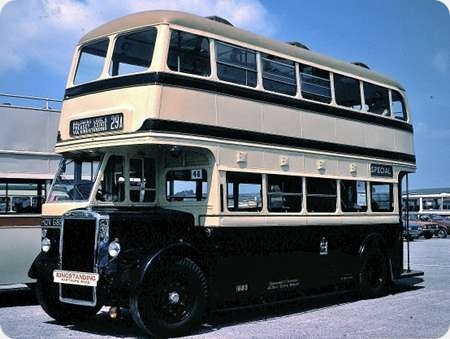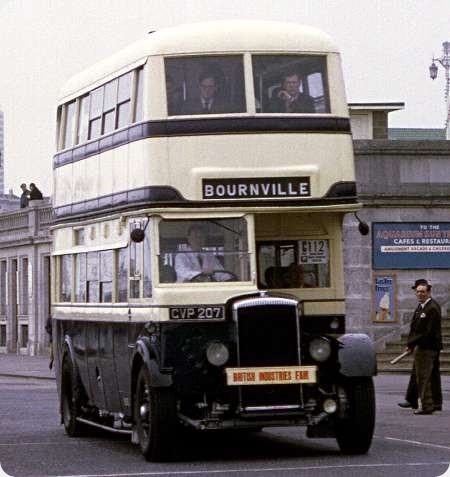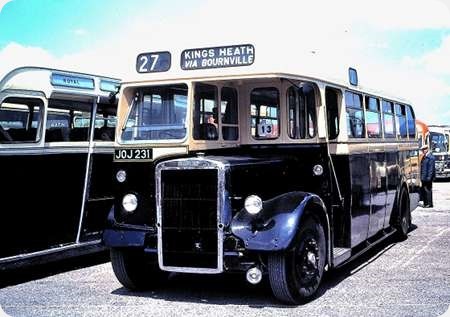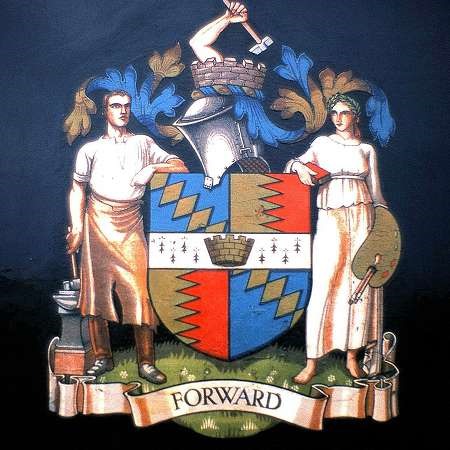
Birmingham City Transport
1948
Leyland Titan PD2/1
Brush H30/24R
HOV 685 is a Leyland Titan PD2/1 with Brush H54R body, to Birmingham’s then standard design. She dates from 1948 and we see her in the Weymouth rally on 1 July 1979. She began her service at Yardley Wood depot and, Malcolm Keeley reports in his book in the Glory Days series, most of the batch so allocated from new remained there throughout their working lives. The others were at Perry Bar. The saga of the Brush bodies is not so happy, however. There had been some earlier disagreements between the builder and the operator, the former managing to convince itself that the product was entirely the opposite of what the operator wanted. This batch appears to have been the last of the Brush bodies for Birmingham.
Photograph and Copy contributed by Pete Davies
05/06/16 – 09:22
Brush had a similar "conversations" with Manchester regarding fifty bodies it was building to the Manchester post war Standard design on Daimler chassis at the same time. Manchester was unhappy with Brush’s interpretation and had to keep a watching brief on the progress to ensure what was produced was identical to the drawings. As it turned out the bodies were well finished and lasted well.
Phil Blinkhorn
07/06/16 – 11:43
Can anybody please explain what the dispute between BCT and Brush was about.
Presumably the operator issued a comprehensive specification of their requirements for the builder to follow
Pat Jennings
07/06/16 – 18:48
Pat, according to his ‘Glory Days’ book on Birmingham City Transport, Malcolm Keeley reports that the rot seems to have set in – in more ways than one – when the timber frame bodies on the surviving 1929-31 AEC Regents had to have new Austerity bodies by Brush in 1943/4. There was supposed to be a decrease in price as a result of salvaging parts from the old bodies, but they had been from four different builders and the cost was actually increased.
The next chapter takes place in respect of the Crossleys ordered in 1945. They should have had Brush bodies, but delays in delivering chassis caused Brush to ask to be ‘released’. Not an unreasonable request, perhaps, but Keeley says, "After the wartime disputes over the Regent and CWA bodies, small wonder BCT ceased to employ Brush."
Pete Davies
09/06/16 – 06:45
Pete, that’s all true but the Leylands are 1948 deliveries whereas your comment finishes in 1945. If I were a betting man I’d put good money on Bush having the same approach as it took with Manchester.
Phil Blinkhorn
09/06/16 – 19:08
Phil B, I’ve spent most of the day looking in the Keeley book for his comments about this dispute, so far without success. I’m sure I didn’t dream it. I’ll post further on this in due course!
Pete Davies
10/06/16 – 05:33
Pete, you are quite right in your summary of Malcolm Keeley’s account of the Brush utility bodies for Birmingham, and the consequent decision by BCT not to use Brush any more. The account of the war-time re-bodying of the pre-war AEC Regents (p.26) describes the problems Brush had salvaging material from the old bodies by four makers, and trying to incorporate these into the fifty new bodies. Delivery was delayed because of the interruption to the production system, and additional detail design work was also needed. A major dispute broke out over the cost. (One is illustrated on p.30, and a trainer conversion on p.41). As you say in your original posting, Brush asked to be released from bodying the 10 Crossleys ordered in 1945, because of pressure of other work in their drawing office. They were already committed to 100 bodies on Leyland PD2s. Keeley, on p.48, indicates that BCT ceased to employ Brush, as you quote above.
Michael Hampton
10/06/16 – 10:21
Thank you, Michael . . .
Pete Davies
10/06/16 – 10:21
Thanks Pete and Michael. Perhaps the clue to the similarities to the dispute with Manchester lies in the drawing office.
Phil Blinkhorn




